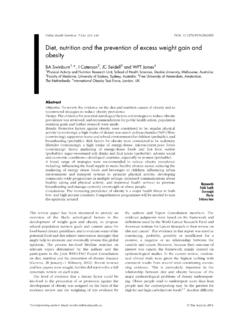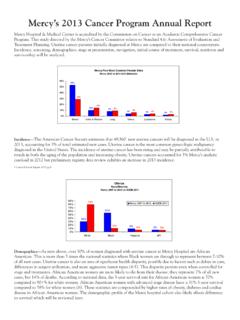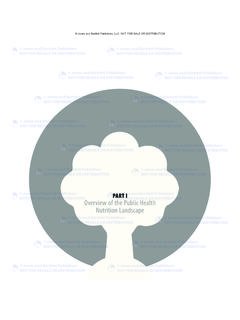Transcription of MODEL PROGRAM: PUBLIC SAFETY PHYSICAL …
1 FitForce, Inc. | 121 Loring Avenue, Suite 220 | Salem, MA 01970 | | email: MODEL PROGRAM: PUBLIC SAFETY PHYSICAL readiness FitForce, Inc. 2010 2 Introduction The decline of health and fitness among those in the law enforcement community is an indisputable fact. The consequences of this phenomenon are also well known; greater vulnerability to on-duty injury and illness, increased exposure to liability and loss of respect by the PUBLIC at large, among others. In 2002 the National League of Cities (NLC) captive reinsurance facility, NLC Mutual Insurance Company, partnered with several law enforcement organizations to form a national Task Group to study the problem and to develop possible solutions. Initial Task Group participants consisted of Commission on Accreditation for Law Enforcement Agencies Fraternal Order of Police International Association of Chiefs of Police National Sheriffs Association National Organization of Black Law Enforcement Executives International Association of Directors of Law Enforcement Standards and Training Police Executive Research Forum American Society for Law Enforcement Training NLC Mutual Insurance Company FitForce.
2 The Task Group held its initial meeting on August 21, 2002 at CALEA headquarters in Fairfax, Virginia. After consideration of this issue by members of the Task Group, it was concluded the drafting of a generic Voluntary Law Enforcement Fitness/Wellness MODEL Program would be the most effective approach. The Task Group envisioned an easily adaptable MODEL , which would be universally viewed as positive and in the best interests of both law enforcement agencies and their personnel. The final version of the MODEL was adequately flexible to permit some FitForce, Inc. 2010 3 expansion by its users to incorporate incentives or other measures should the adopting agency deem it appropriate. This MODEL Program is a revised version of the original. Task Group members signed off on the original version and since then several of the participants have promulgated official statements in support of it. In the interim, principals including the NLC Mutual Insurance Company, FitForce , Risk Probe, Inc.
3 And several state league pools - to date Colorado Intergovernmental Risk Sharing Agency (CIRSA), Florida League of Cities, SAFETY Benefits, Inc. representing South Dakota, and Texas Municipal League Intergovernmental Risk Pool have participated in the development of a pilot program to consider best practices and to test the efficacy of an agency-based health risk reduction focused program. Although the original MODEL program was focused on law enforcement, all PUBLIC SAFETY and other agencies would equally benefit from such a peer counseling approach. In addition, our experience so far has demonstrated the need for a cooperative, collaborative program that emphasizes partnership with community-based medical, education, and fitness resources. The project is a work in progress supported by internet- based resources and those agencies participating. This revision to the MODEL program represents the same approach. In an attempt to better serve the PUBLIC SAFETY community, FitForce , the principal author of the MODEL , is providing this resource and others consistent with the agency-based implementation of same.
4 FitForce, Inc. 2010 4 MODEL Program Mission Statement: Develop a guide for a cost effective, voluntary law enforcement fitness and wellness program that serves the interests of the agency, its individual officers and the community it serves. Facts Bearing on the Mission: A PUBLIC SAFETY PHYSICAL readiness Program helps to ensure that: officers have the requisite fitness to perform their duties; officer s lifestyle habits will decrease health risks and improve quality of life; agencies reduce their liability by ensuring officers PHYSICAL readiness to perform while controlling risk and its associated costs. A PHYSICAL readiness Program has two main elements. The first ensures the development and maintenance of PHYSICAL performance capability, that is the ability to perform job tasks and personal leisure time activities. The second element addresses the officers health status, both present status as well as the risk of future disease. This total fitness- health and PHYSICAL performance is achieved through the development of good lifestyle habits, taught and supported by the agency s administrators.
5 These fitness lifestyle areas - exercise, nutrition, weight management, stress management, tobacco cessation, FitForce, Inc. 2010 5 substance abuse prevention, and health risk management - are the foundation of the agency-based program. Working Definitions A basic and common understanding of the program names and elements is necessary. The capability to perform the essential PHYSICAL tasks at a minimum level of SAFETY and effectiveness requires knowledge, skill and PHYSICAL fitness. We define PHYSICAL Fitness as: the ability to meet life s daily demands, without undue fatigue, while maintaining sufficient energy for leisure time pursuits and to overcome emergency situations that may arise personally or professionally. (Adapted from the President s Council on PHYSICAL Fitness and Sports, 1971). The components of PHYSICAL fitness are: cardiovascular endurance, the ability to deliver oxygen to the working muscles to sustain activity, necessary in 11% percent of foot pursuits and over 50% of use of force encounters 1; anaerobic power, the ability to make short, intense bursts of maximal effort , which underlies the ability to run short distances and up stairs; muscular strength, the muscles ability to generate maximal force, necessary for control and restraint; 1 Wollack & Associates (1992).
6 Multijurisdictional law enforcement PHYSICAL skills survey. Sacramento, CA: Wollack & Associates. FitForce, Inc. 2010 6 muscular endurance, the muscles ability to sustain sub-maximal force, also necessary for lifting, pushing, pulling, carrying; flexibility, the ability to use the available range of motion at a given joint or structure, used in virtually all day to day movements as well as some of the more demanding PHYSICAL tasks; body composition, the ratio of fat to lean muscle mass, associated with PHYSICAL performance and health; agility is the ability to generate speed, to start and stop, and to change direction; explosive leg power is the ability to generate force or overcome resistance rapidly as in jumping. Health is frequently thought of as the absence of symptoms. However, due to the aging process, symptom-less diseases and the nature of the PUBLIC SAFETY work environment, apparent health may only be temporary. A more comprehensive definition suggests health is a state of complete PHYSICAL , mental and emotional well being.
7 Wellness may subsequently be defined as those purposeful actions taken to attain and maintain optimal health and fitness. These definitions indicate fitness, health and wellness are not synonymous but integrally related and complimentary. Therefore, a total fitness and wellness program rather than simply a fitness program or wellness program is recommended. FitForce, Inc. 2010 7 Fitness and Health A review of the current fitness and health status of Americans overall and PUBLIC SAFETY specifically provides further justification for an agency-based intervention. More than 50% of the deaths in this country are related to lifestyle choices. Poor lifestyle habits needlessly result in both early deaths and high health costs: cigarette smoking, the single most preventable cause of death and disease in the Unites States, costs over $138 billion a year or almost $3400 per year per smoker in health care costs. Some states such as Massachusetts have a smoking prohibition for PUBLIC SAFETY employees; obesity (+ 25% body fat for males and +30 % for females) is linked to diabetes, hypertension, and cancer as well as orthopedic problems such as low-back pain, for the law enforcement officer.
8 Body fat also affects health, PHYSICAL performance and appearance; poor nutrition accounts for over $33 billion in medical costs and $9 billion in lost productivity due to diet-related diseases. Law enforcement officers have a higher mortality index for diabetes and colon cancer both nutrition-related diseases; alcohol and drug abuse are estimated to cost more than $143 billion annually to taxpayers in preventable health care costs and other expenses; FitForce, Inc. 2010 8 sedentary living doubles the risk of heart disease , and is implicated in higher rates of stroke, colon cancer, and back problems, this combined with the PHYSICAL and mental stress of the job as well as the absence of an agency fitness program contribute to sedentary living; stress accounts for up to two-thirds of visits to primary care physicians, and stress management is consistently defined as an in-service training priority by agencies; health risk reduction refers to the management of known health risks such as pre-diabetes or diabetes, smoking, etc.
9 The Healthy People 2010 initiative identifies 47 prevention goals and measures for individuals in the United States. Coronary artery disease- heart and blood vessel disease and stroke, is the leading cause of death in America. In 2003, an estimated million Americans had a heart attack over 3000 per day. The direct (medical) and indirect (including lost productivity) costs of coronary artery disease were estimated at over $350 billion in 2003. Cancers cost the United States over $170 billion - $110 billion in lost productivity and $60 billion in direct medical costs in 2002. Nearly 20% of all US cancer deaths were due to colorectal, breast, and cervical cancers many of which may be treated or avoided with early detection. As an occupational group, law enforcement officers have greater morbidity and mortality rates than the general PUBLIC , principally due to cardiovascular disease, colon cancer, and suicide. Various law enforcement agencies have FitForce, Inc. 2010 9 calculated the cost of an in-service heart attack to be between $400,000 and $750,000!
10 Surveys suggest heart disease accounts for 20 50 % of early retirements2 and back problems for 15 35%3. In fact, younger officers (<35) have a lower risk of medical problems than the average American but those 35 and older have a higher risk4. One study of a major metropolitan police agency indicated that almost 50% of its officers had at least three of the five major risk factors for heart disease high cholesterol, smoking, obesity, inactivity or poor cardiovascular fitness or high blood pressure5. Finally, most published and anecdotal experience suggests police officers live on average 2-5 years post retirement, depending on the source. This results in a shortened life expectancy. The job itself doesn t cause poor officer health and fitness. The lack of personal and agency fitness programs is more likely the culprit. General population studies suggest that less than 10% of Americans exercise regularly and vigorously enough to improve their fitness and 60 % are not active enough to maintain their current level of fitness.






